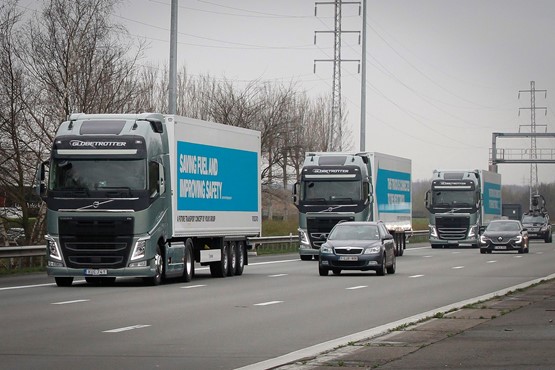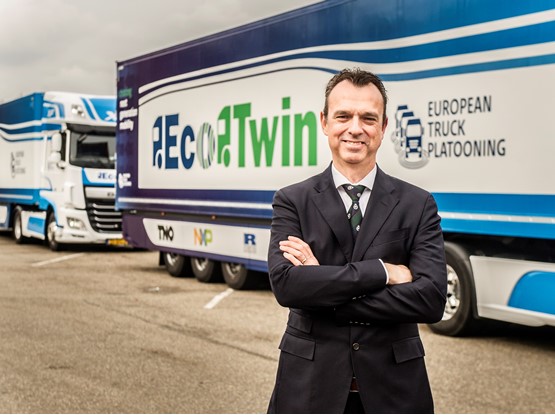Freight companies may discover that operating costs are not such a drag when semi-autonomous trucks can safely line up together to form an orderly, aerodynamic queue. By Tim Blakemore
Time was when the word ‘platoon’ only really came up in discussions related to military matters, or perhaps to the powerful 1986 Oliver Stone anti-war film of the same name.
Not any more.
These days all the talk of platooning is focused on trucks and relates to the pros and cons (mainly the pros) of digitally linking two, three or more semi-autonomous trucks so they can travel closely together in a convoy.
Forming such a convoy lowers the aerodynamic drag for the trucks following the leader, thereby improving overall fuel economy and cutting carbon dioxide (CO2) emissions.
So, it was scarcely surprising when, as part of its 90th anniversary celebrations, Daf Trucks staged a test-track display of vehicles old and new that included the XF tractor/semi-trailer rigs involved in its Eco Twin truck platooning project.
This started three years ago as a partnership between Daf, NXP Semiconductors (the Netherlands-based company which is one of the world’s biggest suppliers of the semi-conductors and radar systems at the heart of platooning technology), TNO (a Dutch research organisation specialising in applied science), and Ricardo (a renowned automotive engineering consultancy based in West Sussex).
There is nothing remotely new about the scientific principles behind platooning or even their application to trucks.
Six years ago, Scania started working on platooning trials with a Swedish road and transport research institute.
“Reducing aerodynamic drag by drafting comes naturally to fish, birds, cross-country skiers and cyclists,” was the memorable observation at the time made by one Scania engineer, Tony Sandberg.
But platooning trials by Scania and others went largely unnoticed by politicians and the public until two years ago when the Dutch government, during its six-month presidency of the European Union, staged the high-profile European Truck Platooning Challenge.

The challenge involved six truck-makers (Daf, Daimler, Iveco, MAN, Scania and Volvo Group) each dispatching a three-truck convoy from separate European cities to arrive in the Dutch port of Rotterdam on April 6, 2016.
The central aim of the exercise was to highlight the disparities in legislation between EU member states that are seen to be acting as barriers to rapid platooning development.
It did the trick. Within days, EU transport ministers confounded critics who accuse them of always moving at snail’s pace by signing up to the Amsterdam Declaration, committing them to rapid harmonisation of WiFi-connected-vehicle legal standards (v2x, in the technical jargon) across Europe.
Where will this leave the UK as it heads uncertainly towards Brexit?
Doubtless this question, though never mentioned publically, of course, was in the forefront of Department for Transport (DfT) and Treasury ministers’ minds last August then they signed off on £8.1 million of Government expenditure on a two-year, UK-specific truck platooning trial.
The three main partners in the project are TRL (a privately-owned Berkshire-based research organisation formerly called Transport Research Laboratory); Daf Trucks, the top-selling truck maker in the UK; Ricardo; and DHL, one of Europe’s biggest transport and logistics groups.
What makes this trial any different from all those that have gone before? Transport minister Paul Maynard is nothing if not ambitious about its potential. “We are investing in technology that will improve people’s lives,” he said.
“Advances such as lorry platooning could benefit businesses through cheaper fuel bills and other road users thanks to lower emissions and less congestion.
But first, we must make sure the technology is safe and works well on our roads, and that’s why we are investing in these trials.”

By no means is everyone convinced, either that yet another platooning trial is the most cost-effective way to spend more than £8 million of public money or that this technology really is capable of delivering in the harsh, real world of road transport anything like the benefits claimed by many advocates.
David Cebon, director of the influential Centre for Sustainable Road Freight (CSRF) and a professor at the University of Cambridge’s engineering department, is among the platooning sceptics.
He points out that far greater operational efficiency gains and cuts in CO2 emissions from freight transport by road are there for the taking and guaranteed if only the Government would allow longer, heavier vehicles, like those that have been successfully trialled many times throughout Europe, to operate on at least some specified UK roads.
He is not alone in being surprised at the Government’s unbridled enthusiasm for electronically linking up to three maximum-weight artics on public roads when it has always turned its face against on-road trials of trucks such as Denby Transport’s B-double, with just one motive unit pulling additional trailers linked perfectly safely and reliably by proven mechanical means.
The Road Haulage Association (RHA) and the main trade union for truck drivers, Unite, are also among those with serious doubts about platooning.
“Of course, we welcome improvements to the way the road freight industry works and we understand the benefits that such a mode of operation would bring,” said RHA chief executive Richard Burnett, following the trial announcement.
“However, currently the focus seems to be on the technology behind the system. Safety has to come first and it cannot be compromised. It is crucial this element of the concept gets the highest priority.”
Unite national officer Adrian Jones expresses other worries about practical considerations.
“While Unite isn’t against the use of technology that makes our members’ jobs easier, it should not come at the cost of jobs and wages of highly skilled lorry drivers,” he said.
“As well as major issues around safety, there’s a whole host of practical issues such as the order of a convoy where different hauliers are involved.
"No haulier will want its lorry at the front of a convoy for too long but, instead in the middle where their lorry will use less fuel than competitors.”

The focus in the rest of the EU, meanwhile, is shifting to multi-brand platooning trials.
A consortium with the dreadfully contrived name of Ensemble (standing for enabling safe multi-brand platooning for Europe) has been formed, involving all six European truck-makers and several big component and system suppliers such as NXP, ZF and Wabco, among others.
"The first three-year Ensemble multi-brand trial starts later this year, with a demonstration on public roads planned for 2021.
The UK seems determined to plough its own platooning furrow. TRL says the objectives for the two-year trial are safety (for drivers, other road users and cyber security), environmental benefits, commercial viability, impact on infrastructure and traffic management, and acceptance of the technology.
It is currently in the planning phase, a 12-month period which will lead to phase two, a four-month initial road trial, in early spring 2019. Phase three will then commence with DHL drivers, lasting eight months.
TRL chief executive Rob Wallis says: “The programme will be extensive, capturing data for 140 journeys in platooning and 140 journeys in normal driving. Each will be aound 100 miles and we will compare the difference.”
The final phase will be the analysis and reporting to make the economic case.
However, views on platooning from fleet delegates at this year’s Microlise conference were mixed, with just 51% of those polled agreeing that it would become a reality in the UK within 10 years.
Daf Trucks chief engineer and product development director Ron Borsboom (below) can be relied upon to give carefully-considered, well-informed comment on all truck topics.

At the company’s anniversary celebrations, he said: “There is still a lot of technical development ahead before platooning can be expected to be in regular use.
“There is still a great deal that has to be sorted out in terms of legislation, liability and public acceptance.
"Hence, platooning is definitely not a technology that will be on the market before 2022, but we will continue actively to develop its capabilities so we are ready when the technology, customers and legislation are ready.
“Every truck needs a man or woman in the cab, and, on secondary roads or in urban areas, the driver needs to be in control.
"Truck platooning is predominantly an efficiency solution for long-haul operations on main roads and motorways, but even then drivers will be on-hand and ready to take control if necessary. Truck platooning is not the beginning of the end of the truck driving profession.
“It simply relieves the workload of the person behind the wheel, helping drivers cope with demands and creating a safer, more efficient highway system.”

















Login to comment
Comments
No comments have been made yet.